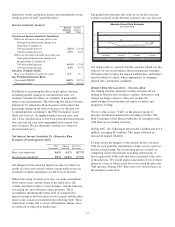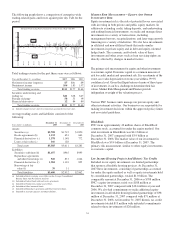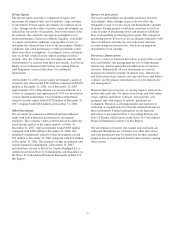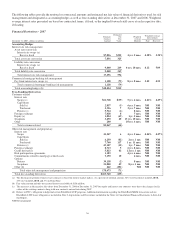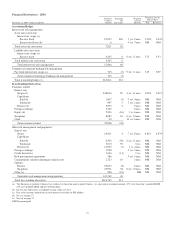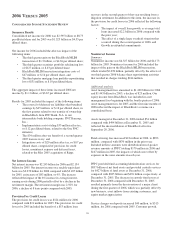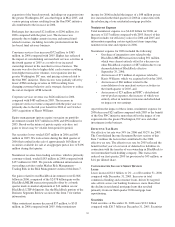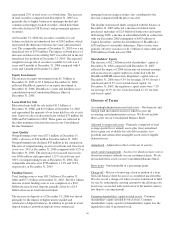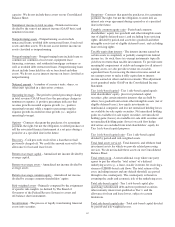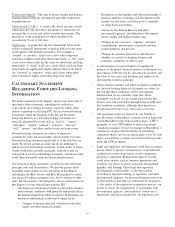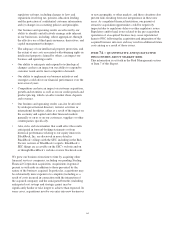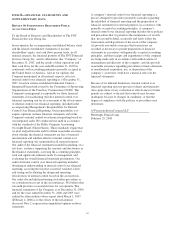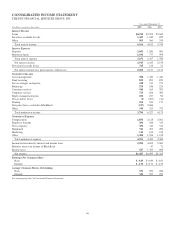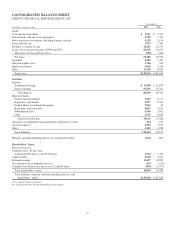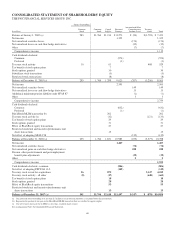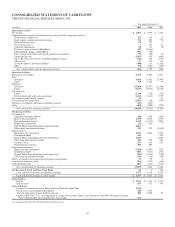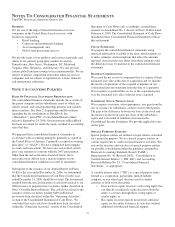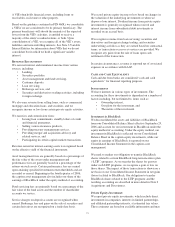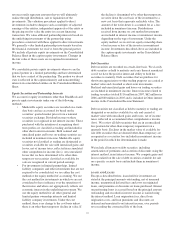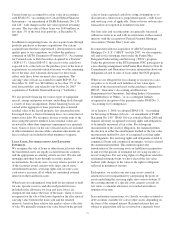PNC Bank 2007 Annual Report Download - page 68
Download and view the complete annual report
Please find page 68 of the 2007 PNC Bank annual report below. You can navigate through the pages in the report by either clicking on the pages listed below, or by using the keyword search tool below to find specific information within the annual report.
Transaction deposits - The sum of money market and interest-
bearing demand deposits and demand and other noninterest-
bearing deposits.
Value-at-risk (“VaR”) - A statistically-based measure of risk
which describes the amount of potential loss which may be
incurred due to severe and adverse market movements. The
measure is of the maximum loss which should not be
exceeded on 99 out of 100 days.
Yield curve - A graph showing the relationship between the
yields on financial instruments or market indices of the same
credit quality with different maturities. For example, a
“normal” or “positive” yield curve exists when long-term
bonds have higher yields than short-term bonds. A “flat” yield
curve exists when yields are the same for short-term and long-
term bonds. A “steep” yield curve exists when yields on long-
term bonds are significantly higher than on short-term bonds.
An “inverted” or “negative” yield curve exists when short-
term bonds have higher yields than long-term bonds.
C
AUTIONARY
S
TATEMENT
R
EGARDING
F
ORWARD
-L
OOKING
I
NFORMATION
We make statements in this Report, and we may from time to
time make other statements, regarding our outlook or
expectations for earnings, revenues, expenses and/or other
matters regarding or affecting PNC that are forward-looking
statements within the meaning of the Private Securities
Litigation Reform Act. Forward-looking statements are
typically identified by words such as “believe,” “expect,”
“anticipate,” “intend,” “outlook,” “estimate,” “forecast,”
“will,” “ project” and other similar words and expressions.
Forward-looking statements are subject to numerous
assumptions, risks and uncertainties, which change over time.
Forward-looking statements speak only as of the date they are
made. We do not assume any duty and do not undertake to
update our forward-looking statements. Actual results or future
events could differ, possibly materially, from those that we
anticipated in our forward-looking statements, and future results
could differ materially from our historical performance.
Our forward-looking statements are subject to the following
principal risks and uncertainties. We provide greater detail
regarding some of these factors elsewhere in this Report,
including in the Risk Factors and Risk Management sections.
Our forward-looking statements may also be subject to other
risks and uncertainties, including those discussed elsewhere in
this Report or in our other filings with the SEC.
• Our businesses and financial results are affected by business
and economic conditions, both generally and specifically in
the principal markets in which we operate. In particular, our
businesses and financial results may be impacted by:
– Changes in interest rates and valuations in the debt,
equity and other financial markets.
– Disruptions in the liquidity and other functioning of
financial markets, including such disruptions in the
markets for real estate and other assets commonly
securing financial products.
– Actions by the Federal Reserve and other
government agencies, including those that impact
money supply and market interest rates.
– Changes in our customers’, suppliers’ and other
counterparties’ performance in general and their
creditworthiness in particular.
– Changes in customer preferences and behavior,
whether as a result of changing business and
economic conditions or other factors.
• A continuation of recent turbulence in significant
portions of the global financial markets could impact our
performance, both directly by affecting our revenues and
the value of our assets and liabilities and indirectly by
affecting the economy generally.
• Given current economic and financial market conditions,
our forward-looking financial statements are subject to
the risk that these conditions will be substantially
different than we are currently expecting. These
statements are based on our current expectations that
interest rates will remain low through most of 2008 and
that economic conditions, although showing slower
growth than in recent years, will avoid a recession.
• Our operating results are affected by our liability to
provide shares of BlackRock common stock to help fund
certain BlackRock long-term incentive plan (“LTIP”)
programs, as our LTIP liability is adjusted quarterly
(“marked-to-market”) based on changes in BlackRock’s
common stock price and the number of remaining
committed shares, and we recognize gain or loss on such
shares at such times as shares are transferred for payouts
under the LTIP programs.
• Legal and regulatory developments could have an impact
on our ability to operate our businesses or our financial
condition or results of operations or our competitive
position or reputation. Reputational impacts, in turn,
could affect matters such as business generation and
retention, our ability to attract and retain management,
liquidity, and funding. These legal and regulatory
developments could include: (a) the unfavorable
resolution of legal proceedings or regulatory and other
governmental inquiries; (b) increased litigation risk from
recent regulatory and other governmental developments;
(c) the results of the regulatory examination process, our
failure to satisfy the requirements of agreements with
governmental agencies, and regulators’ future use of
supervisory and enforcement tools; (d) legislative and
63


